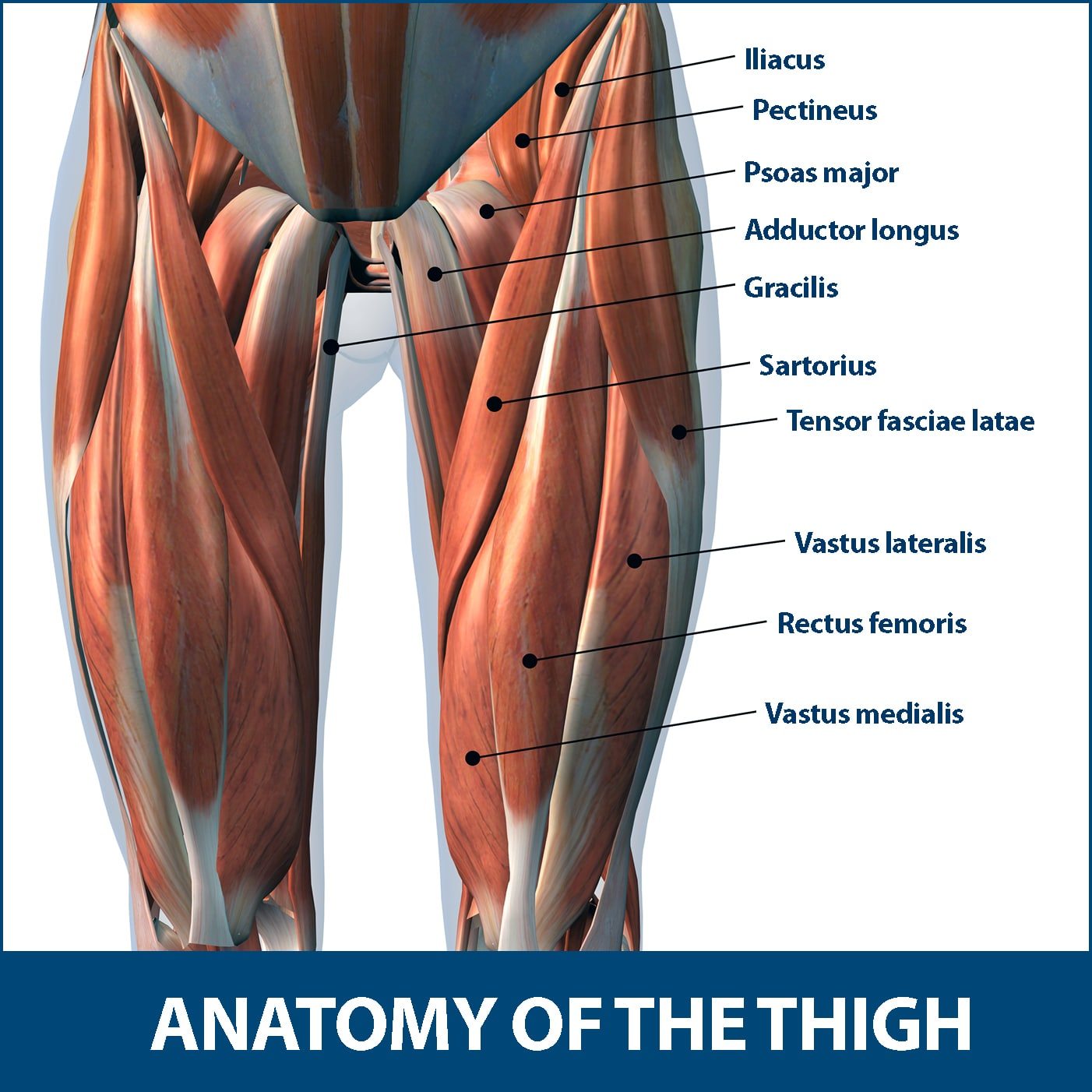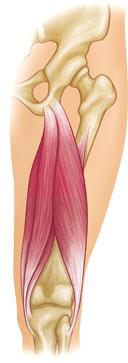Muscle strains (muscle pull or tear), are common injuries, especially among those who engage in sports.
Three sets of strong muscles make up the thigh: the quadriceps muscles at the front and the quadriceps muscle at the back. The adductor muscles are on the inside.
Quadriceps and hamstring muscles are responsible for straightening (extending) and bending (flexing) the legs. The legs are held together by the adductor muscles.
Because they cross the hip and knee joints, muscle strains are more common in quadriceps and hamstring muscle groups.
They are also used in high-speed activities such as track and field (running, hurdles, and long jump), basketball, soccer, and football.
Muscle strains are usually caused by a muscle being stretched beyond its limits, causing muscle fibers to tear. Professional athletes can still experience muscle strain. People who are new to sports, or training to increase muscle, especially leg exercises such as leg press, squats, … can often lead to muscle injuries if done incorrectly.
These injuries often occur at the junction of the tendon’s tough fibrous connective tissue and the muscle. If the muscle is struck directly, it can cause a similar injury. A muscle strain in the thigh may be very painful.
A muscle strain can lead to muscle reinjury. It is crucial to allow the muscle to heal properly and to follow any preventive recommendations from your doctor.
Why is it that some quadriceps and hamstring strains are more difficult to heal than others? What injuries are more likely to recur? As an important component of muscle strain,’ the intramuscular tendon injury has not been given much attention.
The attached tendon extends into the muscle belly of thigh muscles such as the rectus and biceps femoris. Although most muscle injuries occur at the musculotendinous junction of the muscle, the athlete may feel pain in the muscle belly.
The intramuscular tendon is also sometimes injured. These injuries can show up on MRIs in a variety of ways. These injuries may require prolonged rehabilitation and higher recurrence rates.
There is evidence to suggest this. It is crucial to recognize the tendon component of a “muscle strain” in the thighs.
To allow the muscle to heal properly, learn more about muscle strains, including symptoms, prevention, and treatment.
Table of Contents
Thigh Muscle Strains
Thigh muscles anatomy

Three sets of muscles make up the thigh:
- Hamstring muscles: These are located in the back of your thigh. They allow you to stretch and flex your leg.
- Quadriceps muscles are located in the front of your thigh. They allow you to extend and flex your leg.
- To pull the legs together, the adductor muscles are located on the inside of your thigh.
Because the quadriceps and hamstring muscles cross at the knee and hip, there is a high chance of them being pulled.
To avoid further injury, muscles can weaken when they are strained. It is crucial to allow the muscle to heal properly.
Symptoms
A muscle strain in the thigh can cause popping, snapping, or popping sensation.
The pain can be sudden and severe. If blood vessels have been broken, the area around the injury can be tender and may show visible bruises.
Ecchymosis (or “black and blue”) can often be seen below the thigh, reaching the ankle and calf. It may occur as soon as one to two days following the injury.
Grade 1
Grade one thigh strains may not present until the activity has ended. You may feel a tightening sensation in your thighs or cramps, and you might also feel a slight pain when your muscles are contracted or stretched.
Grade 2
A grade two thigh strain causes immediate pain that is greater than a grade one injury. It can also cause pain when you walk. You can feel the pain when you stretch or contract the muscle. Grade two Thigh strains are usually tender to the touch.
Grade 3
Grade three thigh strains are a severe injury that results in a complete tear of a muscle. The athlete will feel a burning, stabbing pain and may not be able to walk.
A lump may appear above the depression and often there is a depression at the site of the tear.
A large bruise will develop below the injury site after a few days of grade two or three injuries. This is due to bleeding in the tissues.
Doctor Examination
Your doctor will ask you about the injury and check your thigh for tenderness. The doctor may ask you to straighten or bend your knees and/or hips in order to confirm the diagnosis.
If there are fractures or other injuries to the bone, an x-ray might be necessary. Muscle strains can be categorized according to severity. Grade 1 strains are mild and heal quickly, while grade 3 strains can cause severe muscle tears that may take several months to heal.
Treatment
The RICE protocol can treat most muscle strains. RICE stands for Rest Ice, Compression, and Elevation.
- Recover. Take a rest from the activity that caused your strain. Crutches may be recommended by your physician to prevent you from putting too much weight on the leg.
- Ice. Avoid applying ice directly on the skin. Cold packs can be used for up to 20 minutes, multiple times per day.
- Compression. Use a light bandage or an ace wrap to protect the area.
- Elevation. To reduce swelling, lift your leg higher than your heart.
For pain relief, your doctor might recommend non-steroidal anti-inflammatory medications such as ibuprofen. Physical therapy can be used to improve strength and range of motion as the swelling and pain subside.
Before you can return to sport, the muscle must be fully functional and pain-free. This will prevent further injury.
Prevention
Risk Factors
There are many factors that can lead to muscle strains.
- Muscle fatigue. Fatigue decreases muscle’s energy-absorbing capacity, making them more vulnerable to injury.
- Poor condition. Your muscles will be less able to handle the stress of exercise, and you are more likely to get injured.
- Muscle tightness. Tightened muscles are more susceptible to strain. An athlete should do daily stretching exercises throughout the year.
- Muscle imbalance. Since the quadriceps muscles and the hamstring muscles are interconnected, it is possible for one to become more stressed than the other.
Take care
High-intensity exercise can also cause muscle tension. Especially with full-body exercises. So to avoid muscle strain, we recommend that you have a training plan with exercises and reasonable intensity. 3 day full body workout plan is a reasonable choice for both beginners and professional gym-goers.
To prevent muscle strain, you can follow these steps:
- Regular exercise can help to condition your muscles. Ask your doctor about exercises for people your age and level of activity.
- Before you start any type of exercise or sports activity, warm-up. Warming up is essential to prepare your body for intense exercise. It increases blood flow, warms the muscles, and improves your breathing. Warming up allows your body to adjust to the demands and demands of exercise. It improves range of motion and decreases stiffness.
- After exercising, take some time to relax. Slowly and slowly stretch, allowing the muscle to relax and allow it to lengthen. This website has examples of stretching exercises. Ask your doctor or coach for assistance in creating a routine.
- Take the time to heal a muscle injury before returning to sport. Wait until muscle strength and flexibility are back to normal. For a mild strain, this can take between 10 and 3 weeks, while for a more severe strain like a hamstring injury, it could take up to 6 months.
Thigh Strain Exercises
Stretching and strengthening should be part of a thigh strain rehabilitation program. This should only be done after the acute phase is over.
It is common for strained thigh muscles to recur so it is important that you do a thorough and gradual rehabilitation program.
Thigh strain stretching exercises
The muscle tends to tighten up after an injury to prevent future injury. This is useful for the initial stages of an injury, but it can also slow down the recovery process and increase your risk of future injuries. Before you attempt any self-help, we recommend consulting a professional.
Exercises that increase active range of motion
This exercise can be useful during the initial stages of rehabilitation when motion is limited.
- Simply straighten your knee and bend it.
- You can do this in a sitting, standing, or lying position.
- Don’t overexert yourself too quickly. Avoid it if it’s painful!
- Do 10 reps at once, at least three times per day.
Static quadriceps stretch
You can do this standing or lying on your back.
- You can gently stretch the front of your thigh by pulling the injured leg’s foot towards your buttock.
- For more stretch, tilt your hips inwardly to increase the position.
- Keep it for between 20-30 seconds, then repeat the process three times.
- This should be done at least three times per day.
Passive quadriceps stretch
You can use an external force to stretch your muscles. This stretch can be done either static or dynamic quad, but you don’t have to do them both.
- A wall can be used by standing in front, bending your knees, and leaning on the foot.
- You can also get a partner to help you push your leg during the laying down stretch.
- Hold for another 20-30 seconds, and then repeat the process three times more, at most 3 times per day.
Hip flexor stretch
This stretch will concentrate on the Iliopsoas and rectus femoris muscles.
- With one knee on the ground, place the other foot in front of you.
- Keep your back straight and push your hips forward.
- The hips and top of your thighs should feel stretchy.
- For 20-30 seconds, hold, then repeat the process three times.
Thigh strain strengthening exercises
As long as the exercises are painless, strengthening exercises can be started. Don’t do it if it hurts. Exercises may be begun as soon as grade 1 is over.
Contractions of the isometric quadriceps
You can use static contractions very early in your rehab. These are contractions that occur without the use of any movement in the leg. You can do this standing or sitting, with your legs straight.
- Ten seconds of contractions at a stretch
- Do 10 repetitions and then relax for 5 seconds. Increase your strength by performing 2 to 3 sets of 10 reps.
- This exercise, although boring, will help maintain muscle mass and get you back to your full fitness quicker.
- Keep at it until you can perform the concentric exercises.
Straight leg raise
You can do this exercise sitting or lying down. It is much easier to lie down. Lie flat on your back, with your legs straight ahead.
- Keep one leg straight and raise the other off the ground.
- For 3 to 5 seconds, hold the position before you lower it to the ground. Repeat the process 10-20 times.
- You can do this exercise daily.
- You can progress the exercise by increasing the duration of the hold and the number of reps.
- To increase difficulty, you can add weight to your knuckles.
Extend your knees
Straightening the knee is done by the quad muscles. You can do this exercise with no weight, ankle weights, resistance machines, or resistance bands.
- Begin with zero weight, then work your way up to ankle weights or resistance bands.
- Straighten your knee and slowly return to the starting position.
- Start with two sets of 10 reps, then gradually increase the weight and resistance to three sets of 15.
Lunges
Lunges, which are a lighter version of a squat, are also known as split squats. Begin with a wide stance.
- Keep your back knee bent towards the ground, but not touching it.
- Your back should be straight and your front knee must not move past the toes.
- Begin by doing 2 sets with the injured leg in front. Next, do 2 sets with the injured side. Gradually, increase your sets to 3 sets.
- You can also add a dumbbell to each hand or a barbell above the shoulders to make it more difficult.
Squats
There are many ways to do squats: ball squats or double-leg squats.
- The easiest exercise is the fit ball squat, so it’s best to start with a single leg and then a double leg.
- You should not bend your knees beyond 90 degrees. Also, make sure that your knees do not move past your toes.
- Begin with two sets of 10 reps, then gradually increase to three sets of 15, before moving on.
- References:
Muscle Strains in the Thigh - https://orthoinfo.aaos.org/en/diseases--conditions/muscle-strains-in-the-thigh/
'Serious thigh muscle strains': beware the intramuscular tendon which plays an important role in the difficult hamstring and quadriceps muscle strains - https://pubmed.ncbi.nlm.nih.gov/26519522/



